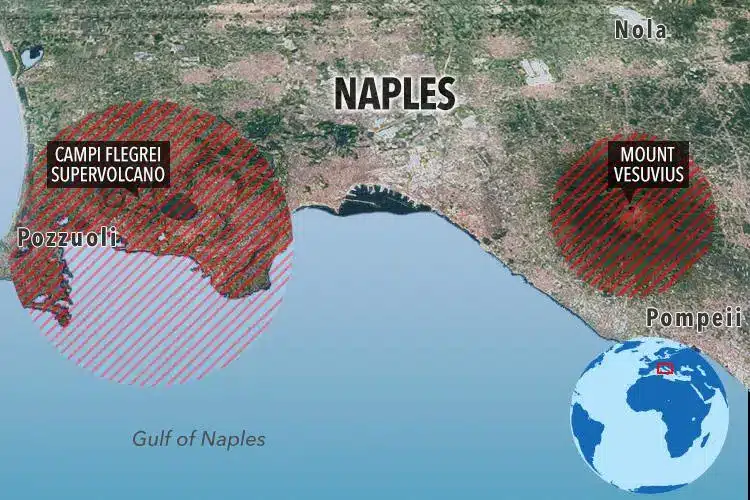A region densely populated to the west of Naples, Italy, has been rattled by hundreds of tremors in recent weeks, the strongest of which was a quake of magnitude 4.2.
Authorities and locals have been cautioned by specialists from the National Institute of Geophysics and Volcanology that earthquakes may intensify shortly, noting that this type of seismic activity is not uncommon in the volcanic region.
For months, the seismic activity has been intensifying. Since the beginning of 2023, we have recorded more than 3,000 tremors, principal researcher at INGV Dr. Gianfilippo De Astis told The Associated Press.”Only 65, however, were above a 2.0 magnitude.”
Three active volcanoes encircle the city of Naples: to the west, the volcanic island of Ischia; to the northwest, the Campi Flegrei; and to the southeast, the Somma-Vesuvius volcanic complex.
Phlegrean Fields, also known as Campi Flegrei, are remnants of a supervolcanic eruption between 37,000 and 15,000 years ago. As the ground collapsed over the magma chamber that had been partially emptied, these two supereruptions produced a caldera that spanned 12K. This modest magma chamber is situated at 2 to 5 kilometers and is gradually refilled by a larger reservoir at an approximate 8 to 10 kilometers depth. There have been 56 minor volcanic eruptions in recent history, the most recent of which occurred in 1538.
Since 2000, extensive hydrothermal activity and seismic disturbances have been documented in the region, which has remained active since the 1950s, 1970s, and 1980s. Bradyseism, a gradual upward and downward movement of the ground, occurs every few decades. Within the Campi Flegrei caldera, the coastal community of Pozzuoli is situated at its core; over the past half-century, it has been raised by approximately 4 meters.
Italy’s Supervolcano Shows Signs Of Seismic Unrest.
A study published earlier this year revealed that volcanic gases and fluids infiltrating fissures and sponge-filling the crust above the magma chamber generated uplift and seismic activity.
This does not inherently indicate that a volcanic eruption is imminent. Yellowstone is experiencing a strikingly identical phenomenon; however, significant eruptions have yet to transpire within its 70,000-year period.
“The situation holds true for every volcano that has remained dormant for generations.” Like comparable volcanoes worldwide, Campi Flegrei Italy may either return to rest or establish a new pattern of gradual ascent and descent. We are currently still determining what will transpire. “It is crucial to be ready for any eventuality,” concluded Dr. Stefano Carlino, an author of the study affiliated with the Vesuvius Observatory.
The dense urbanization in the most active portion of the caldera, where an estimated 300,000 to 600,000 people reside, renders this an area of critical concern under constant surveillance by authorities and researchers. The Italian Defence Ministry raised the alert level from Base to Attention in 2012, the second of four tiers outlined in the Campi Flegrei Italy National Emergency Plan.
SOURCE – (Forbes)










